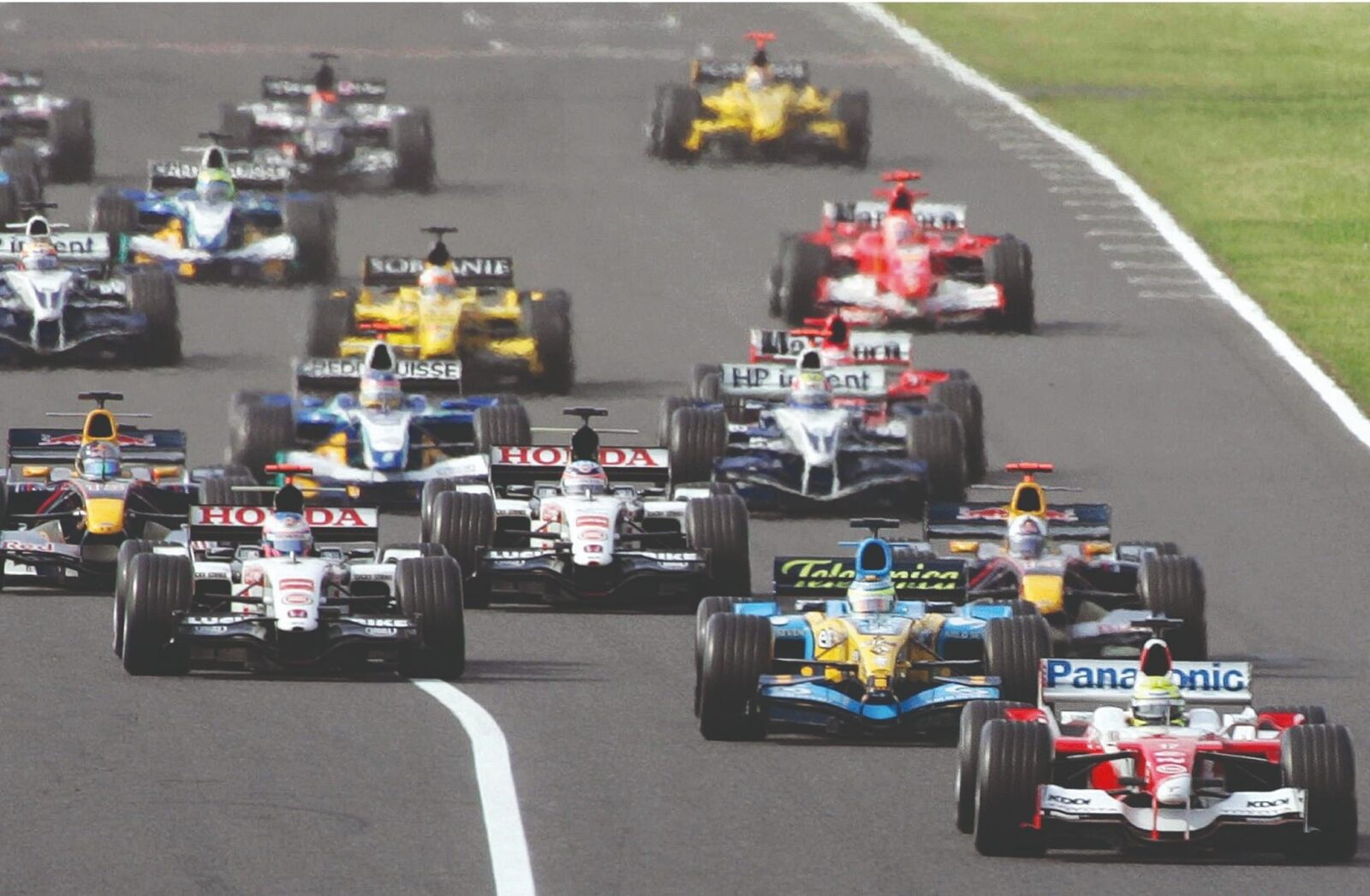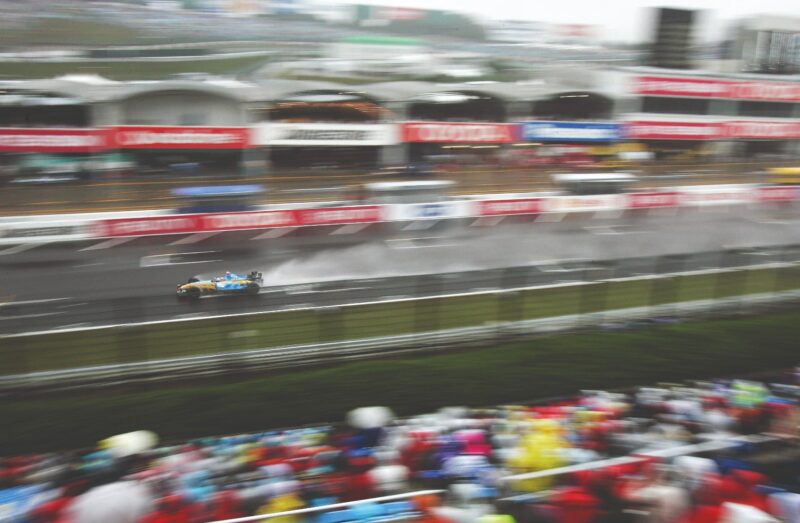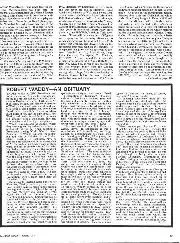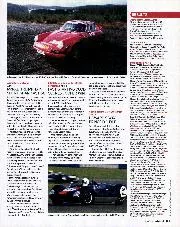Right behind the re-joining Villeneuve, Montoya sensed an opportunity and went for a pass on the left through the right-handed final corner. Villeneuve appeared not to see him and squeezed the McLaren out onto the grass and from there into a heavy collision with the tyre wall, the smoking wreck bouncing back onto the track minus two wheels.
These two Indianapolis 500 winners always had their enthusiasm for each other under control and didn’t give each other any slack afterwards. “He started to go wider and wider and wider – until he pushed me off the circuit,” Montoya complained. “I was 100 per cent beside him, and he just pushed me and pushed me until I was on the grass. [McLaren] probably could have had a 1-2 today, which would have been fantastic for the team.” Montoya was ahead of Räikkönen at the time of the accident, and felt he was the driver who would’ve headed that 1-2. It wasn’t to be. “
I didn’t even know what happened,” Villeneuve said, “He was on the outside, but not next to me. It’s a right-handed corner, so you don’t look left. At some point, he ran out of road. I have no idea what he might have been trying to do when he went off.”
The safety car was deployed and the field bunched up behind it. This ruined the planned three-stop strategy of the light-fuelled race leader Ralf Schumacher, who had been pulling away from the pack. But it had a significance far beyond that. In bunching the field, it wiped out the big field spread from Fisichella back to Schumacher (in seventh), Alonso (eighth) and Räikkönen (12th). The post-hoc analysis strongly suggests that without that, Fisichella would not have been catchable.
Race control confusion
The cars were let loose again after six laps, and immediately Schumacher pounced on the Red Bull of Christian Klien for sixth, and Räikkönen did the same to Massa and Pizzonia to go 10th. After being passed by Schumacher, Klien was immediately being tracked by Alonso, who tried for a pass on the outside approach to the chicane at the end of the lap. But Klien was super-late on the brakes – and Alonso was forced to take to the escape road again to avoid contact. Alonso emerged ahead, but realising it wasn’t a legal pass, he backed off to allow Klien to re-pass. He then slipstreamed him down the pit straight and passed legitimately into Turn 1. Alonso set off to chase Schumacher, surely catchable as the Ferrari F2005 had been no match for the Renault R25 through most of the season.
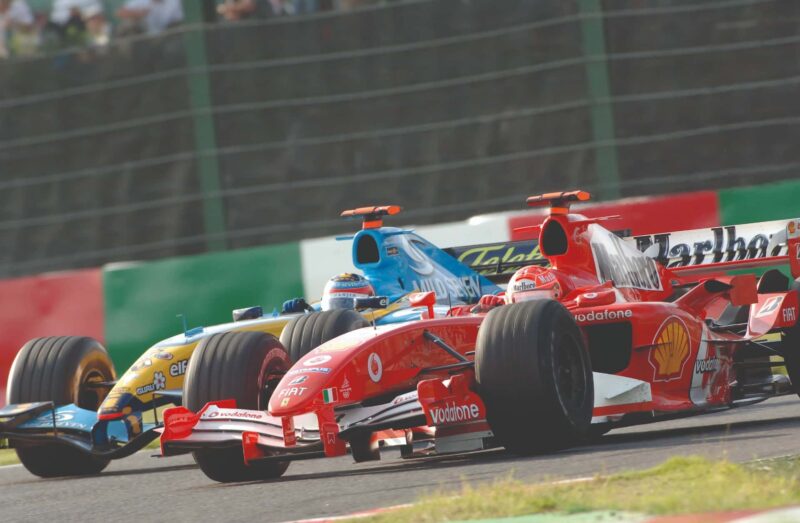
Alonso’s rise: Having taken Michael’s title at the previous race in Brazil, he also pulled a stunning pass at 130R
DPPI
Alonso took 1sec out of him on that lap and at the end of it was visibly faster through 130R and looked set to make an attacking move on the Ferrari into the chicane. But suddenly Alonso backed off. Renault had received a message from race director Charlie Whiting, which said Alonso must surrender his place to Klien as his pass had not been legitimate.
“We sent a message back protesting that he’d already given it back but had re-passed him at the next corner,” explained Symonds. “But we got no response. So rather than losing more time by letting him go on and then having to give it back anyway, we got Fernando to do it as soon as possible.” Alonso was 3sec up the road from Klien, so had to back off to let the Red Bull catch and re-pass once more. “Only then did we get the message back from Charlie cancelling the previous instruction and saying it was okay to retain the place.”
After spending a lap at Red Bull speeds, Alonso passed Klien yet again. The mix-up had cost an immediate 8.8sec – but that was only the beginning of the time penalty Alonso suffered. That 8.8sec delay meant he’d later have to pass the longer-running Schumacher twice rather than once – and this would ultimately allow Räikkönen to get ahead of him. That phantom penalty almost certainly cost Alonso this race.
But that was all yet to play out. For now, Alonso concentrated on catching Schumacher once more, with Räikkönen, having also passed Klien, now right behind him.
F1’s three greatest drivers were now running in tandem, red-blue-silver, making their way towards the front. Alonso had re-caught Schumacher by lap 20, and what followed was one of the most thrilling moments in F1 history. The Renault was faster down the straight that links Spoon to 130R, and as it filled Schumacher’s mirrors, Michael feinted this way and that to try to discourage the pass. He finally staked his claim to the inside approach of 130R, daring Alonso to try the outside. Back in 2005, this corner was nowhere near as comfortably flat as today. To try for the outside was almost unthinkable. But, adrenaline pumping, that’s what Alonso did, running side-by-side with the Ferrari, wheels just a couple of inches apart. Had Schumacher understeered out wide from his shallow entry, they’d have interlocked wheels, and that likely would have been the end of Alonso. But they didn’t, and Alonso made the pass with an apex speed of 208mph… True, they were hardly comparable machines, and Schumacher would go on to fight Alonso for the following year’s title with more equal tools, but there was something symbolic about that move, almost as if a baton was passed. Fisichella’s gentle pace Incredibly, after all the action coming through the pack for 20 laps, Alonso in fifth place was only 10sec adrift of the lead his team-mate Fisi had inherited once Ralf Schumacher’s early fuel stop dropped him well down the field. Fisichella had conspicuously failed to make use of the fantastic opportunity he had to build enough of a gap over the fast cars coming through. He’d completely underestimated the pace he’d need to run and was still assuming he had it under control. From the outside, it was becoming conceivable he’d be caught before the end. In between Fisichella and Alonso at this point were Button, David Coulthard’s Red Bull and Mark Webber’s Williams. They would all later fall to the advances of Alonso and Räikkönen. Webber – who later reckoned he’d done “53 qualifying laps” – passed Coulthard at the first stops and Button at the second.
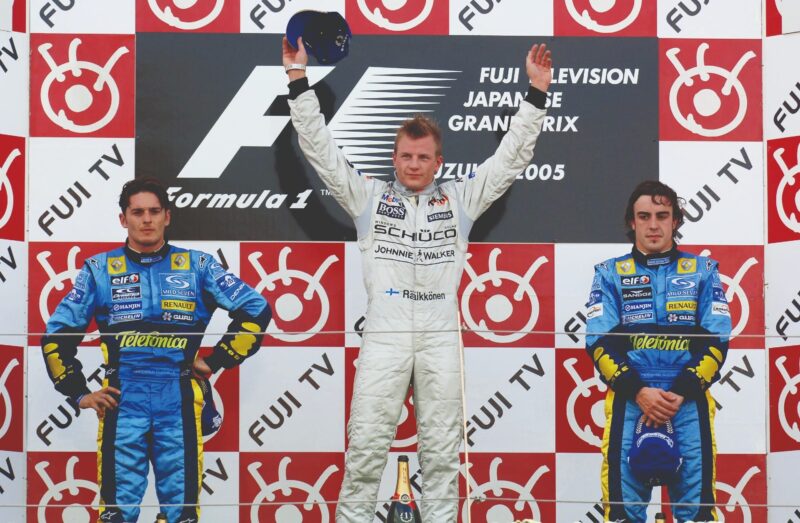
Räikkönen’s late pass on Fisi sealed the win. Alonso, in third, was delayed by a mix-up
Alonso was fuelled only for 22 laps, four fewer than Schumacher and Räikkönen. Which meant he lost places to them both after they’d all made their first stops. Had he not had the phantom penalty, he’d have comfortably cleared them despite the earlier stop. The trio was line astern again, red-silver-blue this time – until Räikkönen made his pass on Schumacher on lap 30, around the outside into Turn 1. He pulled away from the Ferrari at 1sec per lap. Alonso couldn’t hang around behind the Ferrari as Kimi escaped and three laps later dummied Michael into defending the chicane, compromising his entry onto the pit straight, making him a sitting duck into Turn 1. Alonso had now passed Schumacher twice and proceeded to leave him well behind. As he chased Räikkönen, they were lapping at a very similar pace, absolutely on the limit – both around 0.7sec faster than Fisichella in the lead. It was in this middle stint that Fisichella lost the race.
Räikkönen made his final stop two laps after Button/ Webber, those two low-fuel laps enough to spring him past them – and with now just Fisichella ahead. Nine laps to go, 9sec to find. Räikkönen began gaining at 1sec per lap – bang on. As if that weren’t drama enough, Alonso was passing Button and Webber. As he went to pass the Williams on the inside down the pit straight, Webber moved across to dissuade him, leaving less than a car’s width; no matter, Alonso simply put two wheels on the grass. At little short of 200mph in top gear, the Renault telemetry showed he got wheelspin as he made the pass! This was perhaps his best drive ever.
It was probably Räikkönen’s, too. Into the closing laps, he hunted the leader down, and Fisichella began to feel the pressure, defending into the chicane even before Räikkönen had arrived on his tail. This only slowed him, and into that last lap, he entered the straight on a compromised line – and Räikkönen’s chance for an improbable and magnificent win was presented to him.
The R factor
How a tricky Benetton led to Renault’s R25 success
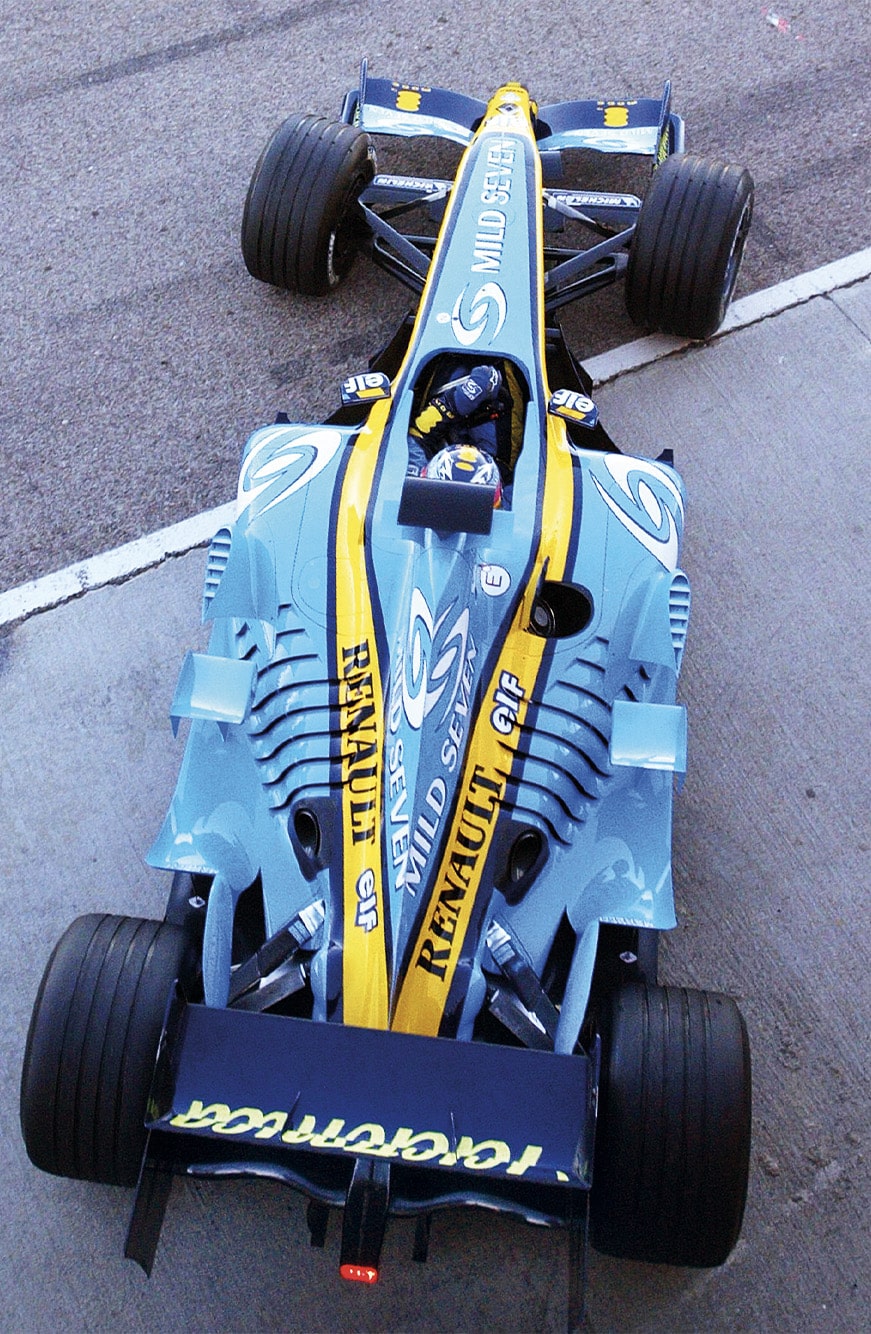
The 2005 championship-winning Renault R25 wasn’t usually as outright quick as its rival – the McLaren MP4-20 – but it was much more reliable. This and a strategically sharp team on the pitwall was all Fernando Alonso needed to take his first title, at the age of 24.
The roots of the car came from the unsuccessful Benetton B201 of 2001 which featured an unusual wide-angle (111-deg) V10, to lower the centre of gravity and reduce the rear bodywork height, improving airflow to the rear wing. Although its poor airbox acoustics meant it was never powerful enough, and poor reliability from the vibration inherent to the v-angle meant adding more weight, it did suggest interesting development areas. As the vibration- afflicted engine developed more torque, its driveability and fuel economy was fantastic. The extra weight upon the rear gave strong traction. The wide-angle engine was abandoned for more conventional and powerful motors, the lessons of its torque curve and rearward weight bias woven into the cars of 2002 onwards, up to the R25 in the last year of V10s.
The car featured a significantly more rearward-bias than the McLaren in both weight and aero distribution. New aero regulations introduced for 2005 targeted a reduction in front downforce by raising the wing. Renault’s pre-existing philosophy was very well suited. It was draggier than the McLaren but had a wide aerodynamic set-up window and strong traction.
